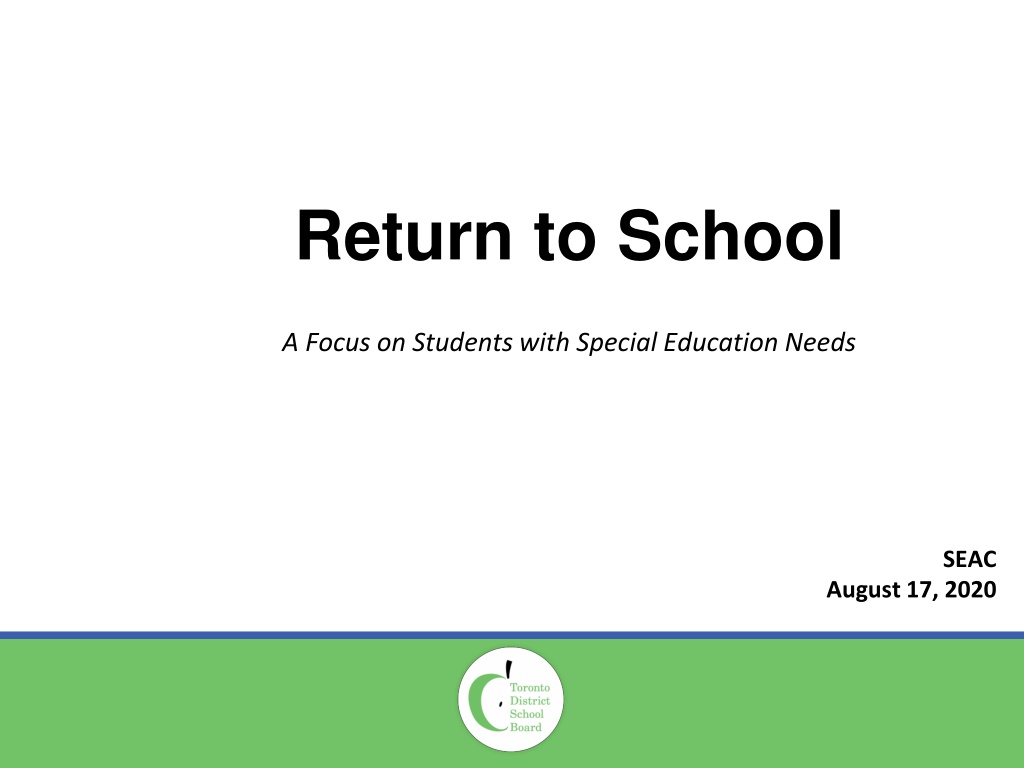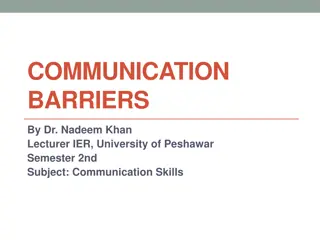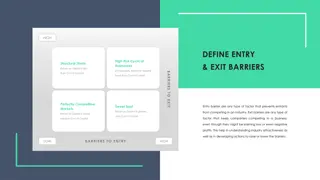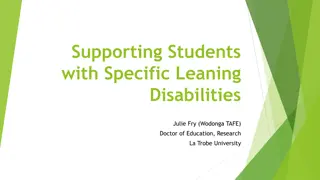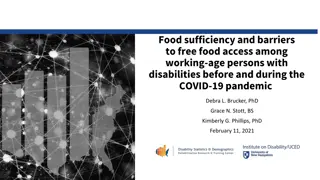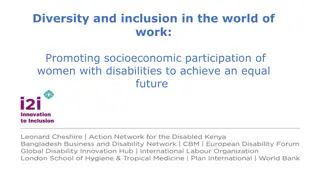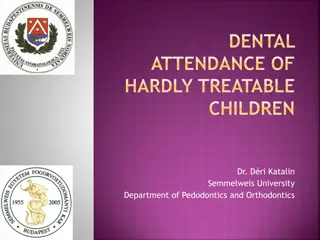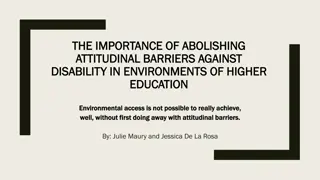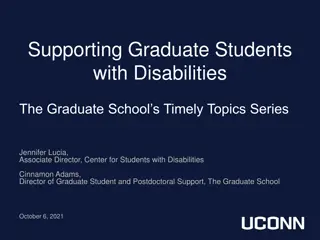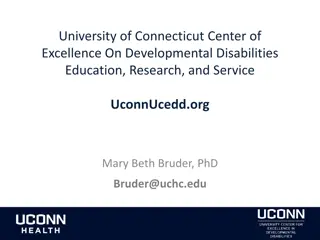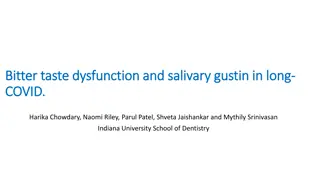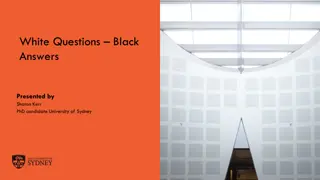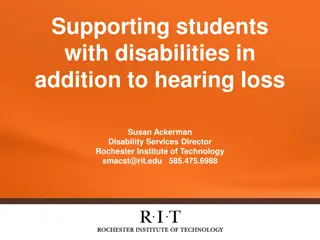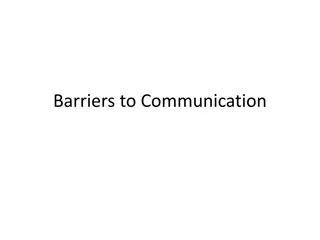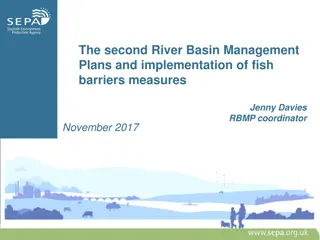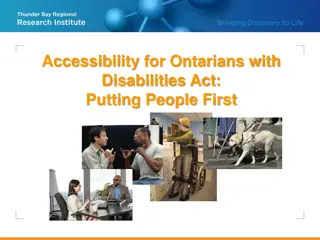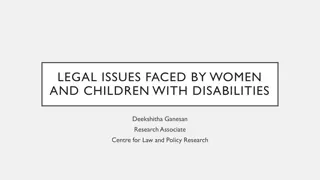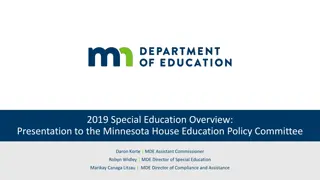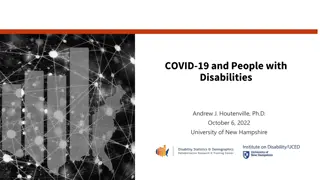Addressing COVID-19 Barriers for Students with Disabilities in Education
The report discusses 9 barriers faced by students with disabilities due to COVID-19, ranging from organizational challenges to mental health issues. Recommendations are provided for the Government and School Boards to enhance emergency planning and safety measures. Additionally, sub-committees focusing on special education and ongoing meetings ensure diverse perspectives are considered in return-to-school operations. Strategies for supporting students with special education needs in regular classes, including various levels of assistance, are outlined to promote inclusive learning environments.
Download Presentation

Please find below an Image/Link to download the presentation.
The content on the website is provided AS IS for your information and personal use only. It may not be sold, licensed, or shared on other websites without obtaining consent from the author. Download presentation by click this link. If you encounter any issues during the download, it is possible that the publisher has removed the file from their server.
E N D
Presentation Transcript
Return to School A Focus on Students with Special Education Needs SEAC August 17, 2020
Covid-19 Barriers for Students with Disabilities & Recommendations : A Report from the Accessibility Education K-12 The K-12 Education Standards Development Committee (The Committee) formed the small group when the Ministry of Education was seeking feedback from the Committee on the barriers and issues identified through the COVID-19 pandemic. The small group s mandate includes using experiential learning from the COVID-19 pandemic to: The report addresses the following 9 barriers for students with disabilities as a result of COVID-19: 1. organizational, policy and procedural barriers 2. mental health and well being 3. academic (learning inequities for students with disabilities) 4. support for secondary school students with disabilities 5. transitions between in school and virtual learning 6. accessible communication and technology 7. training on the integration of digital technology into learning 8. transportation 9. recommendations addressing barriers for the Government and School Boards in emergency planning and safety
Return to School Sub-committees with a Special Education focus Ongoing meetings with Central Steering Return to School Committee with a focus on Operations and Programming Staff Sub-Committee and SEAC Sub-Committee meeting to ensure all voices and considerations are being addressed Meeting regularly with Community Care Coordinators
Regular Class Elementary students with special education needs in regular class will continue to be supported as per their IEP Classroom teachers and special education teachers (e.g., Resource teachers, HSP teachers) will collaborate by co- planning and co-teaching to support students on IEPs (face to face and/or remotely) Regular Class with Indirect Support - students with this designation will continue to receive indirect support from special education teacher through their classroom teacher (face-to-face and/or remotely) 5
Regular Class Regular Class with Resource Assistance - students with this designation will continue to receive direct support individually or in small groups within the regular class from a special education teacher; if student has elected remote learning, support will be provided remotely Regular Class with Withdrawal Assistance - students with this designation will continue to receive direct support outside of the classroom for less than 50% of the school day from a special education teacher (face to face and/or remotely). Withdrawal support can continue while maintaining safe practices such as wearing a mask and keeping the group small We encourage the inclusion of students with special education needs in regular class, consider minimizing the withdrawal of students to reduce contact outside of their cohort; we encourage support as much as possible be provided in the regular class setting 6
Special Education Class Special education class with partial integration: students in this designation will continue to have access to a special education class for at least 50% of the school day, and can continue to be integrated with a regular class for at least one instructional period daily. This includes students in HSP and some ISP programs. As we continue to phase out HSP and move toward inclusion, the support for the student in HSP is encouraged to be provided within the regular class. HSP teachers can continue to support students and work in collaboration with classroom teachers (face to face and/or remotely) Special education class full time: student in this designation will continue to access a special education class daily and will be supported by the special education classroom teacher Integration should continue and students should be considered as part of a cohort of students (e.g., connected to one homeroom class for recess or lunch as noted Elementary limited 50 students and secondary limited to 100 students)
Students with Medical Complexities Schools will continue to work with their respective Community Care Coordinator and Service Providers (SE Health and VHA) to ensure timely and appropriate scheduling for the students who require nursing as part of the return to school transition (e.g., scheduling of students that requires time sensitive nursing interventions such as Aerosol Generating Procedures (AGMP) and g-tube feeding) 8
Elementary Intensive Support Program (ISP) Elementary ISP classes are capped at 6-16 students (excluding Gifted) depending on the ISP program Elementary students in ISP classes will come to school daily and be considered their own cohort; this includes Congregated Sites and all ISP classes in regular K-8 schools (including Elementary Gifted classes which are capped at 25 students) There are a total of 6 congregated elementary sites where students will be able to attend daily; those schools include: Beverley School, Lucy McCormick Senior School*, Park Lane Public School*, Seneca School, Sunny View Junior and Senior Public School, and William J McCordic *schools that have secondary aged students and follow an elementary school model
Secondary ISP Classes Secondary ISP classes are capped at 6-16 students (excluding Gifted) depending on the ISP program Secondary students in DD ISP programs (capped at 10 students) can attend daily as they are grouped as a cohort and can take all their special education classes together; they will follow the semestered track model ISP classes with Integration (including Gifted) Students in secondary ISP (including gifted) who are typically timetabled into special education classes and regular school courses, will come to school as their peers following the secondary school model in order to ensure integration Secondary students in an ISP (capped at 6-16 students) program can attend as one cohort taking special education courses; typically these ISPs would include MID, LD, ASD, DHH and PD and would be cohorted with their peers for non-special education courses (typically the square footage of secondary classes are larger and physical distancing can be accommodated)
Secondary ISP Classes Gifted ISP classes are capped at 30 students and will be divided into 2 cohorts for special education and non-special education classes Secondary schools with ISP class including DD classes will follow a dual track semester that is semester for students in DD programs and quadmester for the rest of the school For the times the students will not be in class (asynchronous learning), the teacher will set up scheduled check-ins to ensure differentiated support is afforded to this cohort of students There are a total of 6 congregated secondary school sites where students can attend daily and these sites will follow the semestered track model (Central Etobicoke High School, Drewry Secondary School, Frank Oke Secondary School, Maplewood High School, Sir William Osler High School, and York Humber High School)
Educational and Community Programs and Partnership (ECPP) (formerly CTCC) Each agency will have a return-to-school plan that will be developed in collaboration with TDSB and that will adhere to Ministry of Education guidelines as well as the guidelines of the Ministry of Children, Community and Social Services and the Ministry of Health and Long-Term Care The plans will vary depending on whether the classroom is located within a hospital setting and/or other health based specifications Student numbers in ECPP per class are less than Ministry guidelines for mainstream classrooms and all students In ECPP programs should be attending full days from a TDSB perspective unless families select remote learning; however, in working within a partnership there is consistently the need for compromise as perspectives differ
Remote Learning PPM 164 Supporting Students with Special Education Needs Where appropriate, educators should provide more opportunities than the minimum requirements for synchronous learning for students with special education needs, based on their individual strengths and needs, and provide differentiated support and instruction. Educators should continue to provide accommodations, modified expectations, and alternative programming to students with education needs, as detailed in their IEPs. If it is not possible to meet a student's needs through synchronous learning, educators and families will work together to find solutions. School boards are encouraged to provide continued access to assistive technology, including Special Equipment Amount (SEA) equipment, where possible, to support students with special education needs as they participate in remote learning. In situations where access to assistive technology is not feasible, educators are expected to work with students and parents to determine workable solutions on an individual basis. PPM 164 Ministry Remote Learning Document
Remote Learning Structure: Daily attendance will be taken; 300 minutes of learning opportunities (synchronous and asynchronous) Synchronous learning (e.g., Whole Group Instruction; Guided Instruction -small group or individual; Check & Connect -small group or individual); Asynchronous independent work available in Google Classroom/Brightspace Parents/guardians will receive a timetable Technica l Digital and Non-Digital: Students will continue to access their SEA devices and equipment; should the family choose remote learning non-digital, the teacher will continue to program for the student based on IEP strengths and needs; the school will arrange for family access of non-digital resources Remote Learning web site will continue to be updated Regular Class: Students with special education needs in regular class with resource assistance or withdrawal assistance who elect remote learning will have a teacher assigned (from current school or other) to support their learning
Remote Learning ISP Class: Students with special education needs in an ISP who elect remote learning, will have a teacher (from current school or other) to support remote learning; schools will work in collaboration with ES to ensure teachers assigned to remote learning have Spec Ed Qualification Technica l Learning Focus: Learning will be based on the Overall Expectations of the Ontario Curriculum, Kindergarten Program and/or Alternative Curriculum Schools will follow the Individual Education Plan (IEP) requirements. Teachers will work collaboratively with families and the IEP team to ensure the IEP reflects learning goals, updates, assessment and evaluation that reflects the remote learning environment The Classroom teacher will program for the student based on IEP learning goals
Individual Education Plan Schools will follow the 30 day IEP requirement as per Reg 181/98 Learning goals will be created collaboratively with the IEP team and parents to address both face to face and remote learning scenarios Teachers will continue to be responsible for student programming for both face-to-face and remote learning Teachers will continue to ensure that IEPs are updated at each reporting term Teachers and support staff will collaboratively support synchronous and asynchronous learning for all students. Schools will accommodate students who require non-digital resource
In-School Team Meeting (IST) and School Support Team (SST) Meetings can be scheduled as usual once per month and/or depending on needs Principals will have autonomy to hold these meetings using either one or a hybrid of both virtual (AODA platform-ZOOM) and face-to-face models to accommodate attendees; Paraprofessionals will be included as usual (e.g. Social Worker, Speech and Language Pathologist, Psychologist, other) to be in attendance
IPRCs and SEPRCs IPRCs Regulation 181/98 will resume remotely upon written parental request and school for: an increase in level of support a change of exceptionality students seeking a change of ISP (type) Once IPRC committees are established for this school year, all IPRCs can resume
IPRCs and SEPRCs Schools will continue to establish an IPRC committee for Level 3 Original Gifted with the support of Special Education Inclusion Consultant and schedule meetings remotely SEPRC are not Ministry mandated; however, meetings for students with complex medical needs can continue Over the summer months, Psychologists completed outstanding assessments; if criteria is met then IPRC can be scheduled
Itinerant and Regional Support Services (e.g., ASD, BRS, BLV, DHH) Continue with referral as usual and consider the transition of students who receive Tier 3 itinerant support Minimize school visits when possible by providing virtual options For students who choose remote learning, support will be provided virtually
Summer Transition Day The Ministry has provided funding to support the summer transition of students with high special education needs, as a result of the COVID-19 pandemic school closure. Schools with Intensive Support Programs (not including gifted) received funds to support the transition of students with high special education needs the last two weeks leading up to the return to school in September
Summer Transition Day Schools will determine how to best use the funds to support the summer transition for their students as considering that many students returning back to school after an extended time away will require additional support to re-learn and adjust to new routines associated with the measures from Toronto Public Health as it relates to social distancing, cohorting and changes to school and classroom settings and routines.
Special Equipment Amount Beginning in September 2020, SEA equipment will be tracked in SAP CRM. Schools will be sent their SEA inventory to confirm. Training and support will be available in September 2020 Students will continue to have access to the devices that they have been sent at the onset of our transition to remote learning in March due to the school closures; the decision of returning the device to school daily or keeping it at school or home can be made in collaboration between the school and the student/family
Accessibility Use of board-approved synchronous and asynchronous learning platforms to be fully accessible (e.g., Zoom) Encourage that the use of accessible features (e.g., Closed Captioning) are enabled Monitor students resources to support the delivery of remote learning
Personal Protective Equipment (PPE) Initial PPE will be provided by the Board for all students and staff and delivered to schools prior to school opening School Administrators can order PPE through the TDSB Distribution Centre based on the needs of the staff (surgical masks, gloves, gowns, face shields, etc.,) and students (non surgical masks or face coverings) in their ISP classes The TDSB Distribution Centre has been given a list of Congregated Sites and schools with ISP classes to flag as priority schools due to the unique circumstances they support; PPE is managed through Occupational Health and Safety 26
Personal Protective Equipment (PPE) Although masks are required for students in Grade 4-12, exceptions will be made for students with special education needs if required Instructional information & training will be provided regarding the proper use of masks (e.g. informational posters, videos, etc.) student screening tool https://www.toronto.ca/wp- content/uploads/2020/08/94e5-Survey-poster-Schools.pdf Screening for students who are non-verbal, and/or have a speech, language or hearing disorder: https://drive.google.com/file/d/19t_8A9MoL4fA2m90nixoyg2f9Yxj IdTA/view?usp=sharing 27
Transportation Busses will be running at full capacity on a staggered start with a seating plan for all students; windows are recommended to be open; siblings and students in the same class can sit together Masks required for all bus riders, who don t have an exemption; Enhanced cleaning of all buses, including wiping down all high touch surfaces between runs Special education students prioritized for busing to start the year. As a result, TDSB and TCDSB will be proceeding with the following staggered start for student transportation services to begin the 2020-21 school year: During week 1 of the school year (September 8-11) only students with special education needs will be provided with student transportation. Beginning September 14 (week 2 of the school year), all other eligible students will be provided with student transportation, unless there is a significant driver shortage or other unforeseen issues related to COVID-19 that may require they are pushed back further. 28
Transportation- COVID-19 and Bus Safety The following COVID -19 safety protocols/precautions are being implemented by TSTG and school bus operators to help ensure the safety of students and drivers on student transportation services: Requiring that all students (K-12) wear non-medical face coverings (exceptions will be made for students with medical conditions or other special exemptions); Requiring that all bus drivers wear medical masks and/or face shields; Assigning seats for students with siblings and classroom cohorts seated together; and, Enhanced cleaning of high touch surfaces (e.g. seats, inside hand railing, interior windows and walls, etc.) before and after each shift, as well as in between runs. Please see the full list of health and safety protocols and precautions to ensure the health and well-being of all students and drivers on bus. 29
Transportation Leading up to the first day of school, parents/guardians will receive an automated phone call from TSTG reconfirming their child s start date (Week 1 or Week 2). This phone call will be sent during the week of August 31. Students specific route information will be available during the week of August 24. To access your child s transportation information, please visit the Transportation Portal, email transportation@torontoschoolbus.org or call 647-790-3829. Elementary: Bussing for students in Elementary will have pick up and drop off times that reflect full day school learning times Secondary: Bussing for students in DD ISP will have pick up and drop off times that reflect full day learning Bussing for students in an ISP class (capped at 6-16 students) who are integrated in courses will have pick up and drop off times as per the alternate secondary model; typically these ISPs would include MID, LD, ASD, DHH and PD 30
PR 699 & Safety Plans Ongoing support and training will be provided in Non-Violent Crisis Intervention (NVCPI) and personal protective equipment (PPE) training will be provided Safety Plans will also continue on a needs basis; Safety Plans will be reviewed and updated annually by the school and in consultation with families 33
Organizational, Policy & Procedures PR 699 Students with Special Needs: Management Process for Risk- Of-Injury Behaviours PR 575 Access to Schools by Third Party Professionals PR 548 Promotion, Transfer and Retention: Grades 1 to 8 PR 543 Promotion, Transfer and Retention: Grade 8 to Grade 9 PPM 140 Incorporating Methods of Applied Behaviour Analysis (ABA) into the Programs for Students with Autism Spectrum Disorder (ASD) PR 724 Refusal to Admit - Caring and Safe Schools PPM 81 Provision of Health Support Services Settings. 34
PA Day Professional Learning September 1,2,3 Professional learning and capacity building opportunities will be provided to educators who support students with special education needs and will focus on: Developing high levels of digital competencies (Google Classroom & Brightspace learning platforms) PR 699 and Safety Plans (Safety Plan development in SAP CRM) IEP Development and Transitions SEA Inventory in SAP CRM PPM 140 ABA and PPM 156 Transitions Accommodations and Modifications (focus on Remote Learning) Occupational Health and Safety Required PL around health and safety training, personal protective equipment (PPE) use and other safety protocols (e.g., physical distancing, epidemiology )
